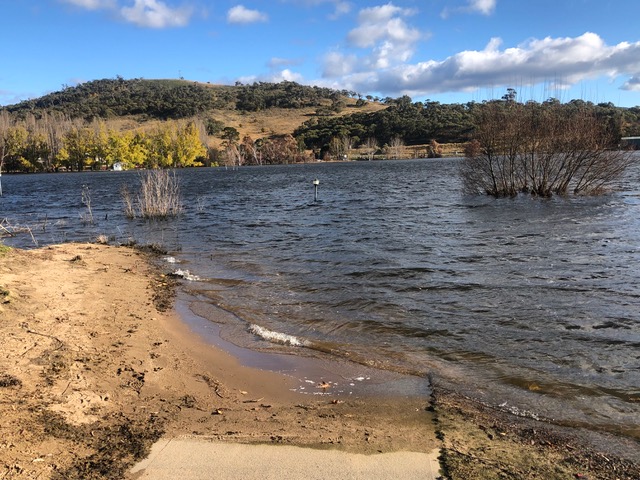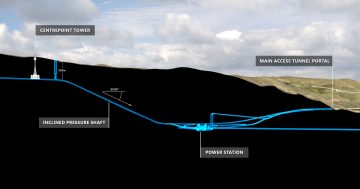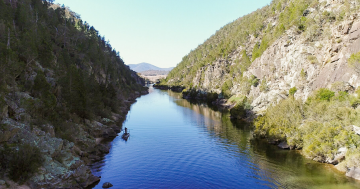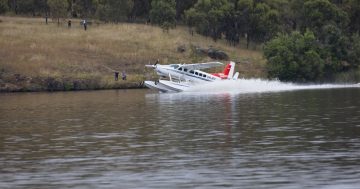
The Lake Jindabyne foreshore. Photo: Steve Osborne.
Now the waters of Lake Jindabyne are receding, it is becoming clear to us all what happens when the lake is kept at high levels for a long period of time.
The foreshores, dubbed the “jewel in the crown”, are now shabby, sometimes destroyed, and may be permanently damaged.
The shared trails around the foreshore, where they were inundated, are now often dangerous, unusable or have disappeared.
The businesses around the foreshore, largely accommodation, are struggling to offer space to visitors, and those who offer bike or sailing hire will be wondering whether they can carry on.
The recreation and picnic areas, playgrounds, fitness spots, traffic barriers and garbage collection bins are now a mess, covered in mud and debris. Our one formal public space, Banjo Paterson Park, is now a muddy wasteland surrounded by dying trees.
The banks of the lake, especially those facing north-west, have been subject to wave and wind damage and some areas are too dangerous to visit.
This is a gloomy picture to wake up to. There is much to be done to reclaim our foreshores, and we have to turn our attention to a plan for the future.
Who actually is responsible for the work that has to be done?
Snowy Hydro has always taken the position of “I told you so”, saying that the 100 per cent line was well known and anyone who involved themselves in infrastructure or activities below that line had only themselves to blame.
In reality, this attitude may well have been relevant in the early days, but it now no longer holds credibility. When the lake started to fill, Jindabyne was a tiny place, almost a dependant serf on the mighty Snowy Scheme.
Times have changed.
Jindabyne has grown in its own right, as a home for thousands of people, and a destination for year-round tourists, who come for the snow and the lake. A relationship has grown up between the town and the lake that could not have been foreseen by the Snowy engineers.
Snowy Hydro has also changed. It has tried, and to a large extent succeeded, to close up with the community: “The communities in which we operate in the mountains remain critical to our success,” say its publicists. It is a major sponsor of community events, and has an active and positive place in the life of the area.
They have maintained the lake levels only twice at more than 92 per cent. The rest of the time, the levels have averaged 60-80 per cent, and they have not run out of water for irrigation or power generation.
The level of the lake has only reached 98 per cent once before, in 2012, and while it peaked at 100 per cent on 5 March, Snowy Hydro managed releases to bring the level below 90 per cent in two weeks. This was largely due to a release below the dam. During that time, Banjo Paterson Park was inundated, as were the foreshores around the Horizons resort and the Claypits. It was a novelty for Jindabyne, but during the high-water time there were some high winds and waves, and considerable damage was done to the lake banks, which were repaired over two years with sloping rock walls protecting the banks.
The lake was above 98 per cent between December 2021 and June 2022, much longer than the previous inundation.
A solution to the problem would be for Snowy Hydro to redefine the 100 per cent level: that is, when the lake is full and water has to be released.
If the new “Full Level” was at the current 92 per cent, then the foreshores will never be inundated again. The levels will obviously fall below that for many months and we will have the huge beaches and the accompanying dust storms, but the foreshores, infrastructure and public enjoyment of the area won’t be affected. And there won’t be the clean-up and restoration costs involved.
And so the questions remain: Who will be responsible for the repairs necessary now? Will Snowy Hydro accept the benefits of redefining the “Full Level” and seeing that their relationship with the town can only be enhanced, and demonstrate that they see this relationship as evolving and growing?
Snowy Monaro Regional Council has a huge role to play in this. Its Land and Property Project 12.3.2.2 states:
“Demonstrate elevated engagement with Snowy Hydro with the aim of securing positive outcomes to foreshore space engagement.”
So, maybe the two organisations will get together and secure a “positive outcome” for Jindabyne.
Steve Osborne has worked and lived in the mountains for 28 years. As a Jindabyne resident, he’s an active user of the lake and its foreshores.
Original Article published by Steve Osborne on About Regional.
















